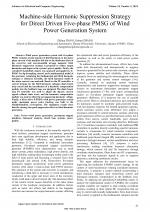| 2/2024 - 9 |
Machine-side Harmonic Suppression Strategy for Direct Driven Five-phase PMSG of Wind Power Generation SystemJIANG, Z. |
| Extra paper information in |
| Click to see author's profile in |
| Download PDF |
Author keywords
wind power generation, permanent magnet machines, harmonic analysis, closed loop systems, power quality
References keywords
wind(13), power(12), harmonic(12), current(12), control(10), energy(9), system(8), systems(7), synchronous(7), pmsg(7)
Blue keywords are present in both the references section and the paper title.
About this article
Date of Publication: 2024-05-31
Volume 24, Issue 2, Year 2024, On page(s): 85 - 92
ISSN: 1582-7445, e-ISSN: 1844-7600
Digital Object Identifier: 10.4316/AECE.2024.02009
Web of Science Accession Number: 001242091800009
SCOPUS ID: 85195639813
Abstract
Wind power generation system with five-phase PMSG contains a large amount of third harmonic in the stator phase current of the machine side due to the dead-time effect of the converter and non-sinusoidal air-gap magnetic field. Harmonic suppression strategy is proposed to reduce output harmonics and improve the system's power quality. Firstly, the extended Clark&Park matrix was analyzed and applied to F-PMSG for dq decoupling control, and a mathematical model of the generator containing the fundamental and third harmonic subspace is obtained. Secondly, the third harmonic model of the stator current was analyzed. Based on the PI controller, a control strategy for the third harmonic subspace dual closed-loop control and the introduction of a harmonic compensation module into the feedback loop was designed. The dual closed-loop PI controller was used to adjust the dq-axis current signals without static error, and the harmonic compensation module was used to offset the accompanying harmonic voltage. Finally, a direct drive F-PMSG wind power generation system under maximum power point tracking was built in the Matlab/Simulink environment. The simulation results show that the strategy has good suppression effect on third harmonic generation. |
| References | | | Cited By |
Web of Science® Times Cited: 0
View record in Web of Science® [View]
View Related Records® [View]
Updated today
SCOPUS® Times Cited: 0
View record in SCOPUS® [Free preview]
There are no citing papers in the CrossRef Cited-by Linking system.
Disclaimer: All information displayed above was retrieved by using remote connections to respective databases. For the best user experience, we update all data by using background processes, and use caches in order to reduce the load on the servers we retrieve the information from. As we have no control on the availability of the database servers and sometimes the Internet connectivity may be affected, we do not guarantee the information is correct or complete. For the most accurate data, please always consult the database sites directly. Some external links require authentication or an institutional subscription.
Web of Science® is a registered trademark of Clarivate Analytics, Scopus® is a registered trademark of Elsevier B.V., other product names, company names, brand names, trademarks and logos are the property of their respective owners.
Faculty of Electrical Engineering and Computer Science
Stefan cel Mare University of Suceava, Romania
All rights reserved: Advances in Electrical and Computer Engineering is a registered trademark of the Stefan cel Mare University of Suceava. No part of this publication may be reproduced, stored in a retrieval system, photocopied, recorded or archived, without the written permission from the Editor. When authors submit their papers for publication, they agree that the copyright for their article be transferred to the Faculty of Electrical Engineering and Computer Science, Stefan cel Mare University of Suceava, Romania, if and only if the articles are accepted for publication. The copyright covers the exclusive rights to reproduce and distribute the article, including reprints and translations.
Permission for other use: The copyright owner's consent does not extend to copying for general distribution, for promotion, for creating new works, or for resale. Specific written permission must be obtained from the Editor for such copying. Direct linking to files hosted on this website is strictly prohibited.
Disclaimer: Whilst every effort is made by the publishers and editorial board to see that no inaccurate or misleading data, opinions or statements appear in this journal, they wish to make it clear that all information and opinions formulated in the articles, as well as linguistic accuracy, are the sole responsibility of the author.





